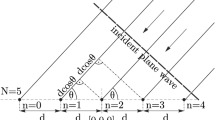Abstract
An augmented joint domain localized technique for computationally efficient polarimetric space–time adaptive processing (pSTAP) is proposed. In the proposed method, the signal vector to be detected is first estimated by using a modified least square method, and then the clutter plus noise covariance matrix (CNCM) required by pSTAP is estimated by using a newly developed dimension-reduced (DR) scheme in which the auxiliary channels in the neighbor of the target cell and the clutter ridge are jointly exploited. The inversion of the DR preprocessed CNCM estimate is finally computed via LU factorization for compensating the additional computations caused by the use of the increased auxiliary channels in the new DR procedure. Simulation results are included to illustrate the performance of the proposed method.









Similar content being viewed by others
Data Availability
All data included in this study are available upon request by contact with the corresponding author.
References
T. Ahmed, X. Zhang, Z. Wang, DOA estimation for coprime EMVS arrays via minimum distance criterion based on PARAFAC analysis. IET Radar Sonar Navig. 13(1), 65–73 (2018)
S. Chintagunta, P. Ponnusamy, 2D-DOD and 2D-DOA estimation using the electromagnetic vector sensors. Signal Process. 147, 163–172 (2018)
W. Du, G. Liao, Z. Yang, Clutter space-time covariance matrix estimate based on multi-polarised data. IET Radar Sonar Navig. 8(9), 1109–1115 (2014)
C. Fowlkes, S. Belongie, F. Chung, J. Malik, Spectral grouping using the Nyström method. IEEE Trans. Pattern Anal. Mach. Intell. 26(2), 214–225 (2004)
I. Griva, S. G. Nash, A. Sofer, Linear and nonlinear optimization (Springer, New York, 2009)
R. Klemm, Dr EI Eng, Adaptive airborne MTI: an auxiliary channel approach. IEE Proc. F (Commun. Radar Signal Process.) 134(3), 269–276 (1987)
R. Klemm, Principles of space-time adaptive processing (IET Press, London, 2002)
C. Luo, Z. He, J. Li, et al, A modified dimension-reduced space-time adaptive processing method. in IEEE Radar Conference (2014), pp. 0724–0728
W.L. Melvin, Space-time adaptive radar performance in heterogeneous clutter. IEEE Trans. Aerosp. Electron. Syst. 36(2), 621–633 (2000)
H.R. Park, H. Wang, Adaptive polarisation-space-time domain radar target detection in inhomogeneous clutter environments. IET Radar Sonar Navig. 153(1), 35–43 (2006)
I.S. Reed, J.D. Mallett, L.E. Brennan, Rapid covergence rate in adaptive arrays. IEEE Trans. Aerosp. Electron. Syst. 10(6), 853–863 (1974)
Y.L. Wang, J.W. Chen, Z. Bao et al., Robust space-time adaptive processing for airborne radar in nonhomogeneous clutter environments. IEEE Trans. Aerosp. Electron. Syst. 39(1), 70–81 (2003)
H. Wang, L. Cai, On adaptive spatial-temporal processing for airborne surveillance radar systems. IEEE Trans. Aerosp. Electron. Syst. 30(3), 660–670 (1994)
J. Ward, Space-time adaptive processing for airborne radar (IET, London, 1998)
F. Wen, J. Shi, Fast direction finding for bistatic EMVS-MIMO radar without pairing. Signal Process. 173, 107512 (2020)
F. Wen, J. Shi, Z. Zhang, Joint 2D-DOD, 2D-DOA, and polarization angles estimation for bistatic EMVS-MIMO radar via PARAFAC analysis. IEEE Trans. Veh. Technol. 69(2), 1626–1638 (2020)
D. Wu, Z. Xu, L. Zhang, Z. Xiong, S. Xiao, Performance analysis of polarization-space-time three-domain joint processing for clutter suppression in airborne radar. Prog. Electromagn. Res. 129(7), 579–601 (2012)
D. Wu, Z. Xu, Z. Xiong, L. Zhang, S. Xiao, Polarization-space-time joint domain processing for clutter suppression in subspace leakage environments. Proc. IEEE CIE Int. Conf. Radar 1, 692–695 (2011)
Y. Zhou, L. Wang, Y. Li et al., A fast iterative three-dimensional joint domain localized method in airborne MIMO radar. Circuits Syst. Signal Process. 38(7), 3370–3383 (2019)
Author information
Authors and Affiliations
Corresponding authors
Additional information
Publisher's Note
Springer Nature remains neutral with regard to jurisdictional claims in published maps and institutional affiliations.
Rights and permissions
About this article
Cite this article
Zhao, K., Liu, Z., Shi, S. et al. Augmented Joint Domain Localized Method for Polarimetric Space–Time Adaptive Processing. Circuits Syst Signal Process 40, 3592–3608 (2021). https://doi.org/10.1007/s00034-020-01634-0
Received:
Revised:
Accepted:
Published:
Issue Date:
DOI: https://doi.org/10.1007/s00034-020-01634-0




